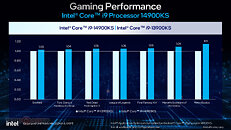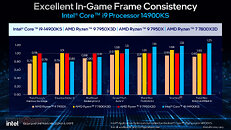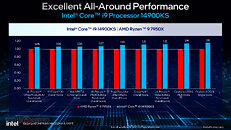- Joined
- Oct 9, 2007
- Messages
- 47,299 (7.53/day)
- Location
- Hyderabad, India
| System Name | RBMK-1000 |
|---|---|
| Processor | AMD Ryzen 7 5700G |
| Motherboard | ASUS ROG Strix B450-E Gaming |
| Cooling | DeepCool Gammax L240 V2 |
| Memory | 2x 8GB G.Skill Sniper X |
| Video Card(s) | Palit GeForce RTX 2080 SUPER GameRock |
| Storage | Western Digital Black NVMe 512GB |
| Display(s) | BenQ 1440p 60 Hz 27-inch |
| Case | Corsair Carbide 100R |
| Audio Device(s) | ASUS SupremeFX S1220A |
| Power Supply | Cooler Master MWE Gold 650W |
| Mouse | ASUS ROG Strix Impact |
| Keyboard | Gamdias Hermes E2 |
| Software | Windows 11 Pro |
Intel today launched the Core i9-14900KS Special Edition desktop processor, which forms the company's new flagship product in the desktop segment. The Core i9-14900KS is based on the same "Raptor Lake Refresh" silicon as the i9-14900K, and offers an 8P+16E core configuration. What's new is that Intel has increased clock speeds for both the P-cores and E-cores. The P-cores now boost up to 6.20 GHz, a 200 MHz increase over those of the i9-14900K; while the E-cores boost up to 4.50 GHz, a 100 MHz increase. But these tiny speed bumps aren't what make the i9-14900KS special. It's the 320 W Extreme Power Delivery Profile, something the regular i9-14900K lacks. On select Intel Z790 and Z690 motherboards with two 8-pin EPS power connectors, the processor is able to draw large amounts of power to hold onto its high boost frequencies. Intel also made the i9-14900KS from the highest bins of the "Raptor Lake Refresh" silicon.
The Core i9-14900KS comes with a 3.20 GHz base frequency for the P-cores. Each of the 8 "Raptor Cove" P-cores comes with 2 MB of dedicated L2 cache. The 16 "Gracemont" E-cores are arranged in four E-core clusters. Each cluster shares a 4 MB L2 cache among its four cores. The 8 P-cores and 4 E-core clusters share a 36 MB L3 cache. The processor comes with a base power value of 150 W—25 W higher than the 125 W of the i9-14900K. Its maximum turbo power is still 253 W, and is engaged on platforms capable of Intel Performance Power Delivery Profile. It's only with some of the more premium motherboards that the 320 W Extreme Power Delivery Profile is engaged. The Core i9-14900KS is a Special Edition SKU, meaning that it may not be available in all the markets where the i9-14900K sells. Intel is pricing this chip at $690, a $100 premium over the i9-14900K, though interestingly, $50 cheaper than what its predecessor, the i9-13900KS, launched at.
Be sure to check out the TechPowerUp Review of the Core i9-14900KS.

The launch press-deck by Intel, along with its first-party performance claims, follows.























View at TechPowerUp Main Site
The Core i9-14900KS comes with a 3.20 GHz base frequency for the P-cores. Each of the 8 "Raptor Cove" P-cores comes with 2 MB of dedicated L2 cache. The 16 "Gracemont" E-cores are arranged in four E-core clusters. Each cluster shares a 4 MB L2 cache among its four cores. The 8 P-cores and 4 E-core clusters share a 36 MB L3 cache. The processor comes with a base power value of 150 W—25 W higher than the 125 W of the i9-14900K. Its maximum turbo power is still 253 W, and is engaged on platforms capable of Intel Performance Power Delivery Profile. It's only with some of the more premium motherboards that the 320 W Extreme Power Delivery Profile is engaged. The Core i9-14900KS is a Special Edition SKU, meaning that it may not be available in all the markets where the i9-14900K sells. Intel is pricing this chip at $690, a $100 premium over the i9-14900K, though interestingly, $50 cheaper than what its predecessor, the i9-13900KS, launched at.
Be sure to check out the TechPowerUp Review of the Core i9-14900KS.

The launch press-deck by Intel, along with its first-party performance claims, follows.























View at TechPowerUp Main Site



